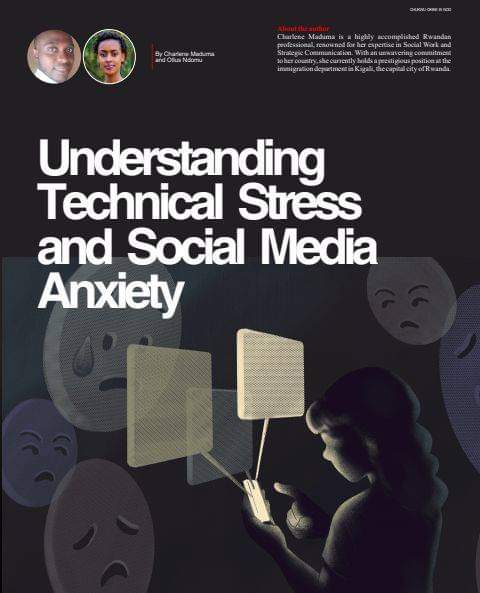
By Charlene Maduma and Ollus Ndomu
In today’s digital age, technology and social media have become an integral part of our lives, connecting us to a vast network of information, communication, and social interactions. However, along with the benefits, there are also concerns about the impact of technology on our mental health. Technical stress and social media anxiety are emerging issues that affect individuals of all ages. This article aims to explore the relationship between technology, social media, and mental health, delving into the symptoms, causes, and consequences of technical stress and social media anxiety. By understanding these issues, we can equip ourselves with strategies to manage our digital lives and promote overall well-being in this increasingly connected world.
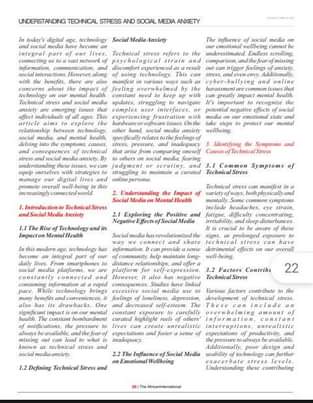
1. Introduction to Technical Stress and Social Media Anxiety
1.1 The Rise of Technology and its Impact on Mental Health
In this modern age, technology has become an integral part of our daily lives. From smartphones to social media platforms, we are constantly connected and consuming information at a rapid pace. While technology brings many benefits and conveniences, it also has its drawbacks. One significant impact is on our mental health. The constant bombardment of notifications, the pressure to always be available, and the fear of missing out can lead to what is known as technical stress and social media anxiety.
1.2 Defining Technical Stress and Social Media Anxiety
Technical stress refers to the psychological strain and discomfort experienced as a result of using technology. This can manifest in various ways such as feeling overwhelmed by the constant need to keep up with updates, struggling to navigate complex user interfaces, or experiencing frustration with hardware or software issues. On the other hand, social media anxiety specifically relates to the feelings of stress, pressure, and inadequacy that arise from comparing oneself to others on social media, fearing judgment or scrutiny, and struggling to maintain a curated online persona.
2. Understanding the Impact of Social Media on Mental Health
2.1 Exploring the Positive and Negative Effects of Social Media
Social media has revolutionized the way we connect and share information. It can provide a sense of community, help maintain long-distance relationships, and offer a platform for self-expression. However, it also has negative consequences. Studies have linked excessive social media use to feelings of loneliness, depression, and decreased self-esteem. The constant exposure to carefully curated highlight reels of others’ lives can create unrealistic expectations and foster a sense of inadequacy.
2.2 The Influence of Social Media on Emotional Wellbeing
The influence of social media on our emotional wellbeing cannot be underestimated. Endless scrolling, comparison, and the fear of missing out can trigger feelings of anxiety, stress, and even envy. Additionally, cyber-bullying and online harassment are common issues that can greatly impact mental health. It’s important to recognize the potential negative effects of social media on our emotional state and take steps to protect our mental wellbeing.
3. Identifying the Symptoms and Causes of Technical Stress
3.1 Common Symptoms of Technical Stress
Technical stress can manifest in a variety of ways, both physically and mentally. Some common symptoms include headaches, eye strain, fatigue, difficulty concentrating, irritability, and sleep disturbances. It is crucial to be aware of these signs, as prolonged exposure to technical stress can have detrimental effects on our overall well-being.
3.2 Factors Contributing to Technical Stress
Various factors contribute to the development of technical stress. These can include an overwhelming amount of information, constant interruptions, unrealistic expectations of productivity, and the pressure to always be available. Additionally, poor design and usability of technology can further exacerbate stress levels. Understanding these contributing factors can help us navigate and manage technical stress more effectively.
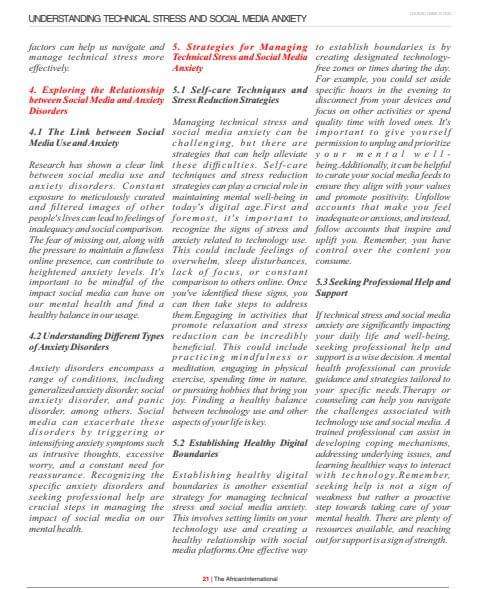
4. Exploring the Relationship between Social Media and Anxiety Disorders
4.1 The Link between Social Media Use and Anxiety
Research has shown a clear link between social media use and anxiety disorders. Constant exposure to meticulously curated and filtered images of other people’s lives can lead to feelings of inadequacy and social comparison. The fear of missing out, along with the pressure to maintain a flawless online presence, can contribute to heightened anxiety levels. It’s important to be mindful of the impact social media can have on our mental health and find a healthy balance in our usage.
4.2 Understanding Different Types of Anxiety Disorders
Anxiety disorders encompass a range of conditions, including generalized anxiety disorder, social anxiety disorder, and panic disorder, among others. Social media can exacerbate these disorders by triggering or intensifying anxiety symptoms such as intrusive thoughts, excessive worry, and a constant need for reassurance. Recognizing the specific anxiety disorders and seeking professional help are crucial steps in managing the impact of social media on our mental health.
5. Strategies for Managing Technical Stress and Social Media Anxiety
5.1 Self-care Techniques and Stress Reduction Strategies
Managing technical stress and social media anxiety can be challenging, but there are strategies that can help alleviate these difficulties. Self-care techniques and stress reduction strategies can play a crucial role in maintaining mental well-being in today’s digital age. First and foremost, it’s important to recognize the signs of stress and anxiety related to technology use. This could include feelings of overwhelm, sleep disturbances, lack of focus, or constant comparison to others online. Once you’ve identified these signs, you can then take steps to address them. Engaging in activities that promote relaxation and stress reduction can be incredibly beneficial. This could include practicing mindfulness or meditation, engaging in physical exercise, spending time in nature, or pursuing hobbies that bring you joy. Finding a healthy balance between technology use and other aspects of your life is key.
5.2 Establishing Healthy Digital Boundaries
Establishing healthy digital boundaries is another essential strategy for managing technical stress and social media anxiety. This involves setting limits on your technology use and creating a healthy relationship with social media platforms. One effective way to establish boundaries is by creating designated technology-free zones or times during the day. For example, you could set aside specific hours in the evening to disconnect from your devices and focus on other activities or spend quality time with loved ones. It’s important to give yourself permission to unplug and prioritize your mental well-being. Additionally, it can be helpful to curate your social media feeds to ensure they align with your values and promote positivity. Unfollow accounts that make you feel inadequate or anxious, and instead, follow accounts that inspire and uplift you. Remember, you have control over the content you consume.
5.3 Seeking Professional Help and Support
If technical stress and social media anxiety are significantly impacting your daily life and well-being, seeking professional help and support is a wise decision. A mental health professional can provide guidance and strategies tailored to your specific needs. Therapy or counseling can help you navigate the challenges associated with technology use and social media. A trained professional can assist in developing coping mechanisms, addressing underlying issues, and learning healthier ways to interact with technology. Remember, seeking help is not a sign of weakness but rather a proactive step towards taking care of your mental health. There are plenty of resources available, and reaching out for support is a sign of strength.
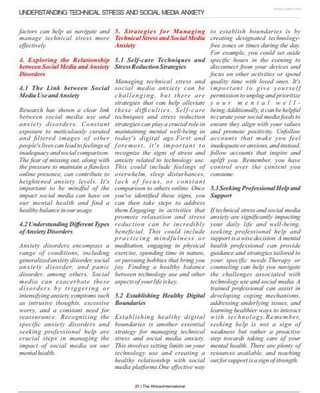
6. The Role of Technology Companies in Addressing Mental Health Concerns
6.1 Ethical Responsibilities of Technology Companies
Technology companies play a significant role in shaping our relationship with technology and social media. It is crucial for these companies to recognize and embrace their ethical responsibilities towards the mental health and well-being of their users. Companies should prioritize user safety and mental well-being over excessive engagement and screen time. This means actively addressing issues such as addictive design elements, targeted manipulation, and the amplification of harmful content. By implementing stricter ethical guidelines, technology companies can promote a healthier digital environment.
6.2 Initiatives and Features Promoting Digital Wellbeing
Fortunately, many technology companies have started to prioritize digital well-being by introducing initiatives and features to promote healthier technology use. For instance, some platforms now offer features that allow users to set time limits on their app usage, mute notifications, or track their screen time. These tools can help users become more aware of their technology habits and make informed choices about their usage. Moreover, technology companies can continue to invest in research and development to create user-centric features that prioritize mental health. By integrating well-being measures into their products and services, these companies can contribute to a more balanced and mindful digital experience.
7. Promoting Digital Wellbeing
7.1 Practical Tips for Reducing Social Media Anxiety
Reducing social media anxiety requires a proactive approach. Here are some practical tips to help you find a healthier balance:1. Limit your social media scrolling time: Set a specific amount of time each day to browse social media, and stick to it. Avoid mindlessly scrolling for hours.2. Unfollow accounts that trigger negative emotions: Surround yourself with positive and inspiring content that uplifts your mood.3. Practice digital detoxes: Periodically disconnect from social media and technology altogether. Use this time to engage in offline activities and connect with the world around you.4. Focus on real-world connections: Cultivate meaningful relationships offline. Spend quality time with friends and family, participate in community activities, or join clubs and organizations that align with your interests.
7.2 Recommended Apps and Tools for Digital Wellbeing
Several apps and tools can help support your journey towards digital well-being and healthier technology use:1. Forest: This app helps you stay focused by growing a virtual tree when you stay away from your phone. The longer you stay focused, the more your virtual forest thrives.2. Moment: Moment tracks your screen time, provides insights into your app usage, and sets daily limits to help you regain control over your technology habits.3. Headspace: This popular meditation app offers guided mindfulness and meditation exercises to help reduce stress and anxiety.4. Ofttimes: Ofttimes allows you to block distractions, set custom schedules for app usage, and track your screen time to promote a healthier balance.
8. Navigating the Intersection of Technology and Mental Health
8.1 Potential Challenges and Opportunities
As technology continues to advance, we can expect both challenges and opportunities in the intersection of technology and mental health. Challenges may include the development of more sophisticated algorithms to capture user attention, the growing influence of social media on self-esteem, and the potential for technology to further isolate individuals from real-world interactions. However, there are also significant opportunities for technology to positively impact mental health. This may involve the integration of artificial intelligence in mental health support, the development of innovative apps and tools for well-being, and fostering a culture of digital literacy and responsible technology use.
8.2 The Importance of Continued Research and Education
To navigate the complex relationship between technology and mental health successfully, continued research and education are essential. Ongoing research can help us better understand the effects of technology on mental well-being and the development of evidence-based strategies for managing related challenges.
It can also shed light on the long-term impacts of technology use and provide valuable insights into how technology can be designed and regulated in a way that promotes mental health. Education, on the other hand, plays a vital role in creating awareness and promoting digital literacy. By equipping individuals with the knowledge and skills to navigate technology in a healthy and responsible manner, we can empower them to make informed choices and build a more positive digital future.
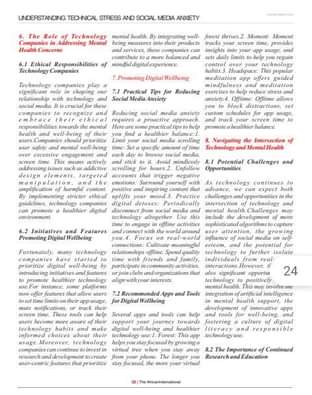
In conclusion, managing technical stress and social media anxiety requires a combination of self-care techniques, healthy digital boundaries, seeking professional help when needed, and the responsible actions of technology companies. By implementing these strategies, utilizing recommended apps and tools, and advocating for continued research and education, we can strive towards a balanced and positive intersection of technology and mental health.
Remember, it’s about finding in conclusion, addressing technical stress and social media anxiety requires a multifaceted approach that includes self-awareness, healthy digital habits, and support from technology companies. By recognizing the impact of social media on mental health, identifying symptoms of technical stress, and implementing strategies for managing digital well-being, we can navigate the intersection of technology and mental health more effectively. It is crucial for individuals, communities, and technology companies to collaborate and prioritize mental health in order to create a healthier and balanced relationship with technology in the future. With the right tools and knowledge, we can embrace the benefits of technology while mitigating the negative impacts, fostering a more positive and mindful digital experience.
FAQ
1. Can social media use really contribute to anxiety?
Social media use has been linked to increased levels of anxiety and stress, especially when there is excessive comparison, fear of missing out, or cyberbullying involved. Research suggests that constant exposure to curated posts and unrealistic standards on social media platforms can negatively impact mental well-being and contribute to feelings of anxiety.
2. How can I manage technical stress and social media anxiety?
There are several strategies to manage technical stress and social media anxiety. These include setting boundaries on social media use, practicing self-care techniques such as mindfulness and relaxation exercises, seeking support from friends, family, or professionals, and engaging in offline activities that promote overall well-being. It’s important to find a balance between technology use and other aspects of life that bring joy and fulfillment.
3. How can technology companies play a role in addressing mental health concerns?
Technology companies can play an essential role in addressing mental health concerns by prioritizing user well-being. This can be achieved through implementing features that promote digital well-being, such as screen time limits, notification management, and user-friendly interfaces. Additionally, companies can provide resources and information about mental health, partner with mental health organizations, and ensure ethical practices in data privacy and content moderation to create a safer and healthier online environment.
4. Is it necessary to completely disconnect from social media to reduce anxiety?
Complete disconnection from social media is not always necessary to reduce anxiety. It depends on individual preferences and circumstances. However, it can be helpful to establish healthy boundaries and limit the time spent on social media platforms. Balancing social media use with offline activities, engaging in hobbies, and focusing on real-life connections can contribute to a healthier and more balanced relationship with technology and reduce anxiety associated with social media.
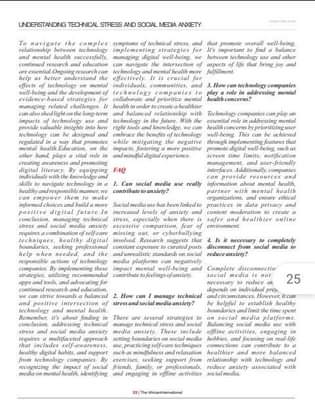
Understanding Technical Stress and Social Media Anxiety – In The African International Magazine- September/October Edition 2023

